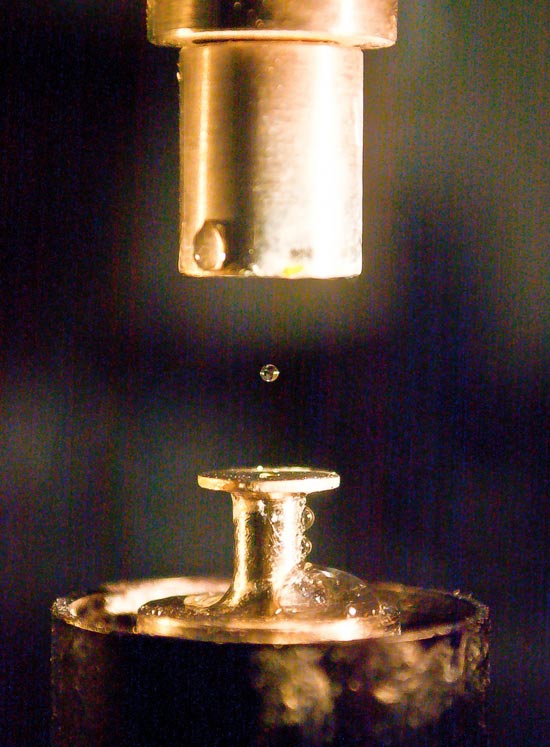New model connects respiratory droplet physics with spread of Covid-19

A droplet suspended in an acoustic levitator Credit: Abhishek Saha, UC San Diego
The team developed this new model to better understand the role that droplet clouds play in the spread of respiratory viruses.
Their model is the first to be based on a fundamental approach taken to study chemical reactions called collision rate theory, which looks at the interaction and collision rates of a droplet cloud exhaled by an infected person with healthy people.
Their work connects population-scale human interaction with their micro-scale droplet physics results on how far and fast droplets spread, and how long they last.
Their results were published June 30 in the journal Physics of Fluids.
“The basic fundamental form of a chemical reaction is two molecules are colliding. How frequently they're colliding will give you how fast the reaction progresses,” said Abhishek Saha, a professor of mechanical engineering at the University of California San Diego, and one of the authors of the paper.
“It's exactly the same here; how frequently healthy people are coming in contact with an infected droplet cloud can be a measure of how fast the disease can spread.”
They found that, depending on weather conditions, some respiratory droplets travel between 8 feet and 13 feet away from their source before evaporating, without even accounting for wind. This means that without masks, six feet of social distance may not be enough to keep one person's exhalated particles from reaching someone else.
“Droplet physics are significantly dependent on weather,” said Saha. “If you're in a colder, humid climate, droplets from a sneeze or cough are going to last longer and spread farther than if you're in a hot dry climate, where they'll get evaporated faster. We incorporated these parameters into our model of infection spread; they aren't included in existing models as far as we can tell.”
The researchers hope that their more detailed model for rate of infection spread and droplet spread will help inform public health policies at a more local level, and can be used in the future to better understand the role of environmental factors in virus spread.
They found that at 35C (95F) and 40 percent relative humidity, a droplet can travel about 8 feet. However, at 5C (41F) and 80 percent humidity, a droplet can travel up to 12 feet.
The team also found that droplets in the range of 14-48 microns possess higher risk as they take longer to evaporate and travel greater distances. Smaller droplets, on the other hand, evaporate within a fraction of a second, while droplets larger than 100 microns quickly settle to the ground due to weight.
This is further evidence of the importance of wearing masks, which would trap particles in this critical range.
The team of engineers from the UC San Diego Jacobs School of Engineering, University of Toronto and Indian Institute of Science are all experts in the aerodynamics and physics of droplets for applications including propulsion systems, combustion or thermal sprays.
They turned their attention and expertise to droplets released when people sneeze, cough or talk when it became clear that COVID-19 is spread through these respiratory droplets.
They applied existing models for chemical reactions and physics principles to droplets of a salt water solution–saliva is high in sodium chloride–which they studied in an ultrasonic levitator to determine the size, spread, and lifespan of these particles in various environmental conditions.
Many current pandemic models use fitting parameters to be able to apply the data to an entire population. The new model aims to change that.
“Our model is completely based on “first principles” by connecting physical laws that are well understood, so there is next to no fitting involved,” said Swetaprovo Chaudhuri, professor at University of Toronto and a co-author.
“Of course, we make idealized assumptions, and there are variabilities in some parameters, but as we improve each of the submodels with specific experiments and including the present best practices in epidemiology, maybe a first principles pandemic model with high predictive capability could be possible.”
There are limitations to this new model, but the team is already working to increase the model's versatility.
“Our next step is to relax a few simplifications and to generalize the model by including different modes of transmission,” said Saptarshi Basu, professor at the Indian Institute of Science and a co-author. “A set of experiments are also underway to investigate the respiratory droplets that settle on commonly touched surfaces.”
Media Contact
All latest news from the category: Studies and Analyses
innovations-report maintains a wealth of in-depth studies and analyses from a variety of subject areas including business and finance, medicine and pharmacology, ecology and the environment, energy, communications and media, transportation, work, family and leisure.
Newest articles

NASA: Mystery of life’s handedness deepens
The mystery of why life uses molecules with specific orientations has deepened with a NASA-funded discovery that RNA — a key molecule thought to have potentially held the instructions for…

What are the effects of historic lithium mining on water quality?
Study reveals low levels of common contaminants but high levels of other elements in waters associated with an abandoned lithium mine. Lithium ore and mining waste from a historic lithium…

Quantum-inspired design boosts efficiency of heat-to-electricity conversion
Rice engineers take unconventional route to improving thermophotovoltaic systems. Researchers at Rice University have found a new way to improve a key element of thermophotovoltaic (TPV) systems, which convert heat…



